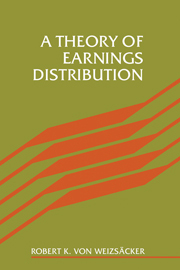Book contents
- Frontmatter
- Contents
- Preface
- Introduction: presentation of problem and overview
- 1 The general structure of the model
- 2 A life-cycle model of individual earnings
- 3 The distribution of earnings within age groups
- 4 The overall distribution of earnings
- 5 The distribution of lifetime earnings
- Selected results
- Appendix 1 Comparative static analysis of the optimal length of basic education
- Appendix 2 Comparative dynamic analysis of the optimal age–earnings profile
- Appendix 3 The distribution factors Va1, Vb, ρa1b: an illustration
- Appendix 4 Technical details for Section 3.4
- Appendix 5 Technical details for Section 4.1
- Appendix 6 Comparative static analysis of optimal lifetime earnings
- References
- Index
- Selected notation
5 - The distribution of lifetime earnings
Published online by Cambridge University Press: 06 July 2010
- Frontmatter
- Contents
- Preface
- Introduction: presentation of problem and overview
- 1 The general structure of the model
- 2 A life-cycle model of individual earnings
- 3 The distribution of earnings within age groups
- 4 The overall distribution of earnings
- 5 The distribution of lifetime earnings
- Selected results
- Appendix 1 Comparative static analysis of the optimal length of basic education
- Appendix 2 Comparative dynamic analysis of the optimal age–earnings profile
- Appendix 3 The distribution factors Va1, Vb, ρa1b: an illustration
- Appendix 4 Technical details for Section 3.4
- Appendix 5 Technical details for Section 4.1
- Appendix 6 Comparative static analysis of optimal lifetime earnings
- References
- Index
- Selected notation
Summary
On the basis of one and the same basic economic model, namely the one contained in Chapter 2, a third distribution level can also be explicitly analysed: that of lifetime earnings.
In fact an examination of the lifetime earnings distribution suggests itself – Chapter 2 is after all concerned with a life-cycle model. The aim of every individual was to maximise the present value of his disposable annual earnings, therefore his disposable lifetime earnings, and the question obviously occurs as to the distribution of this target value. Simultaneously, by way of concentration on lifetime income, the distortion effect induced by the age structure of the population is eliminated (cf. Section 4.4.3).
In contrast to the two previous chapters, the present chapter will no longer restrict itself to snapshots of the distribution situation, but will use the total earnings phase of the economic subjects as the basis for considering inequality issues. This method of observation is of great normative significance. The range of questions treated here can be found in the general outline in the introduction of this book.
The basic set-up
In accordance with the economic model drafted in Chapter 2, every individual j behaves as though he wanted to maximise the value Wj of his disposable annual earnings discounted from the time of his economic birth. In order to obtain the optimal value of his disposable lifetime earnings so defined, the individual must solve a two-stage optimisation problem whose structure the reader may like to visualise with the help of Fig. 7.
- Type
- Chapter
- Information
- A Theory of Earnings Distribution , pp. 163 - 196Publisher: Cambridge University PressPrint publication year: 1993



